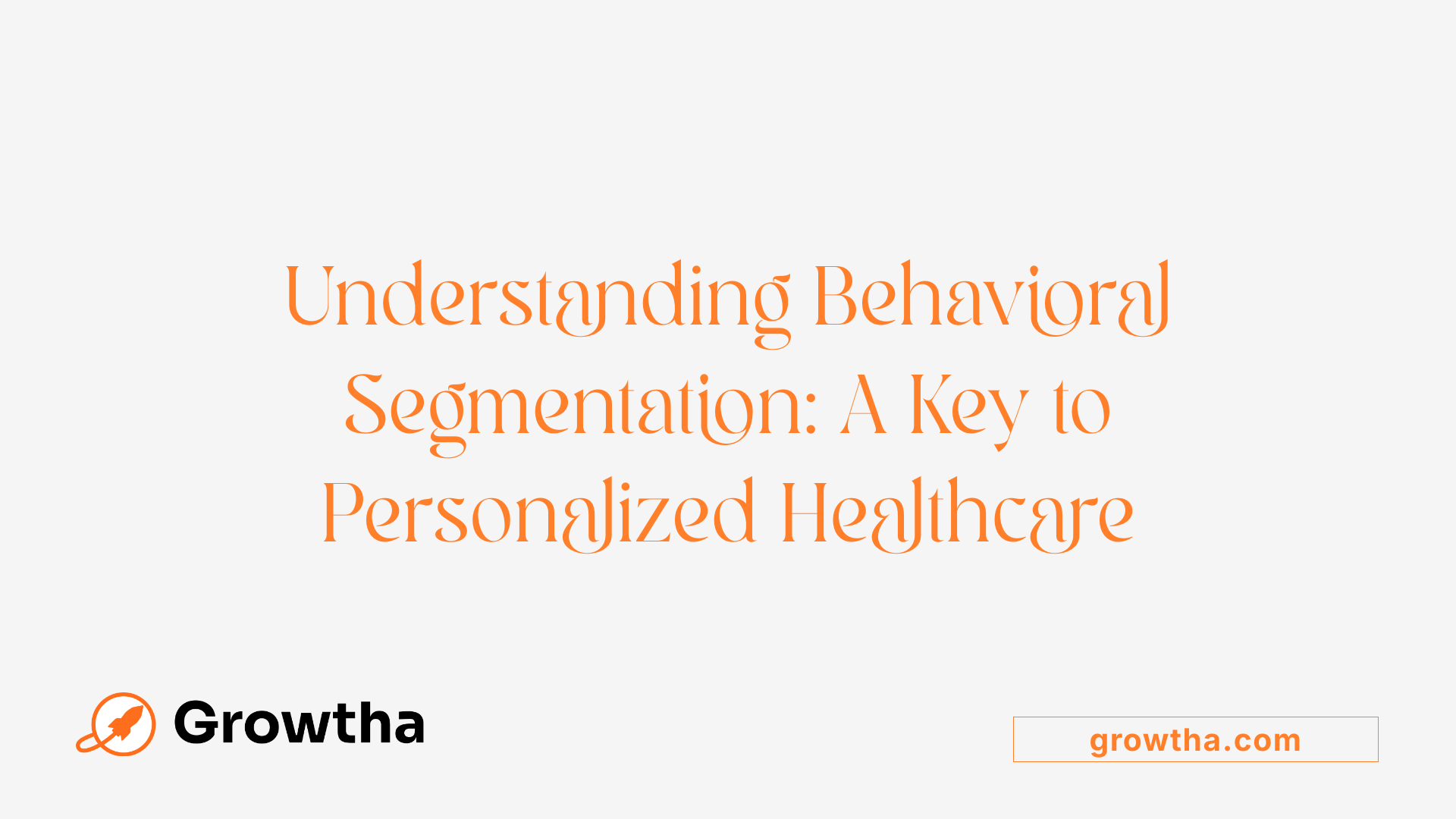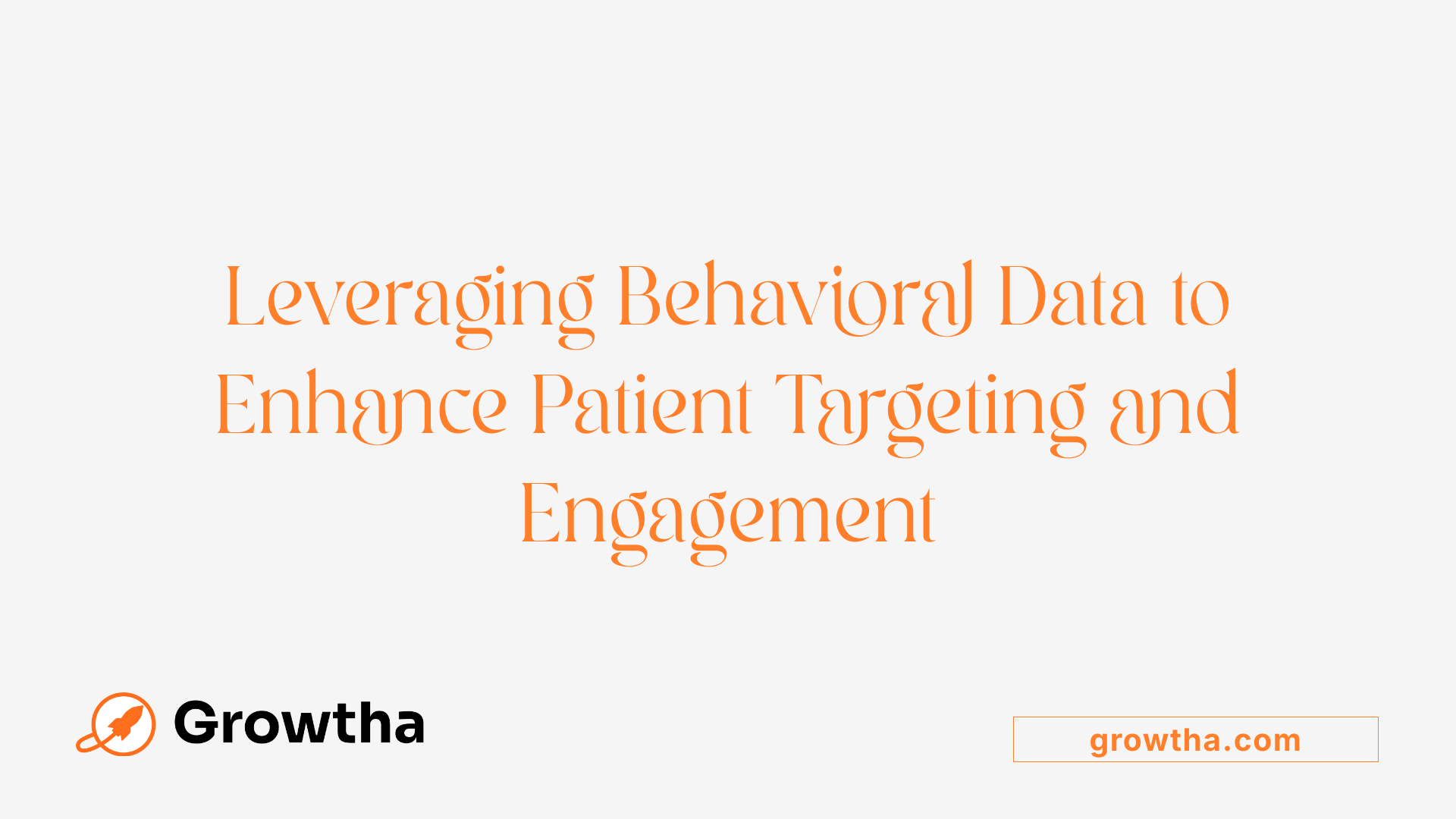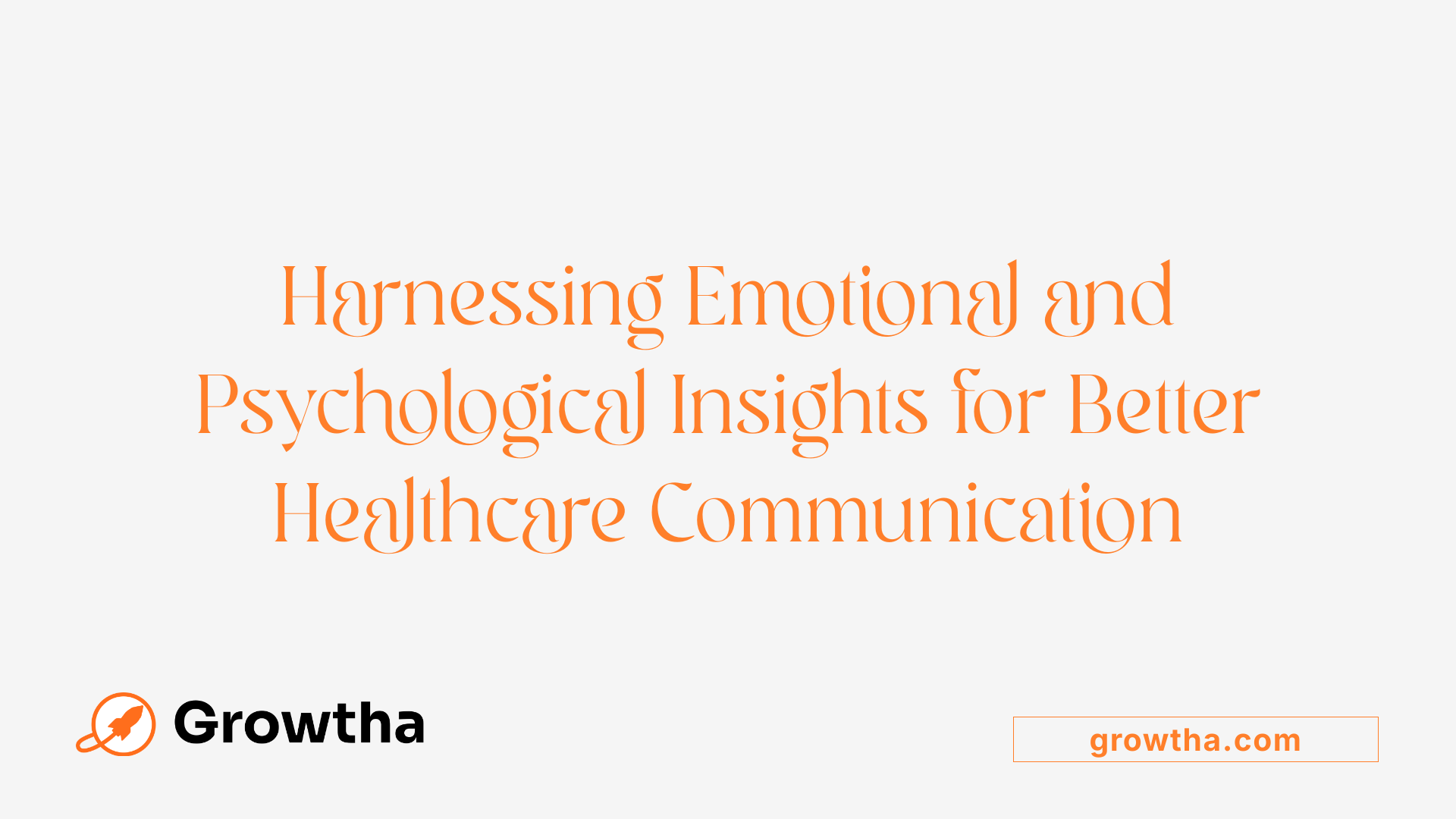How to Use Behavioral Segmentation in Healthcare Campaigns
Harnessing Behavioral Insights for Effective Healthcare Marketing


How to Use Behavioral Segmentation in Healthcare Campaigns
Understanding the Power of Behavioral Segmentation in Healthcare
Behavioral segmentation has revolutionized healthcare marketing by allowing providers to target specific patient groups based on their actions, usage patterns, and engagement levels. This approach ensures personalized communication, enhances patient outcomes, and optimizes resource allocation. As healthcare systems evolve, integrating behavioral insights with advanced data analytics becomes crucial to designing campaigns that are both ethical and effective.
Defining Behavioral Segmentation and Its Significance in Healthcare

What is behavioral segmentation?
Behavioral segmentation is a marketing strategy that groups customers based on their actions, engagement patterns, and behaviors when interacting with a brand or service. Instead of focusing on who customers are demographically, it examines what they do – such as purchase habits, product usage, loyalty levels, and responses to marketing efforts.
In healthcare, behavioral segmentation involves analyzing patients’ healthcare-related actions, like medication adherence, appointment frequency, and health management behaviors. By leveraging data analytics, healthcare providers can identify patterns and create targeted communication that resonates with different patient groups.
This approach often uses tools like customer relationship management (CRM) systems and predictive analytics to gain insights into patient behaviors. Incorporating psychological factors—such as patients’ acceptance of treatments or their perceived control over health—further refines segmentation. This combination of behavioral and psychological understanding allows for more tailored and effective patient engagement.
Why is it important in healthcare marketing?
In healthcare, personalized communication can significantly improve patient outcomes and satisfaction. Behavioral segmentation helps providers deliver relevant messages and services that align with individual patient needs and behaviors.
By understanding how patients interact with healthcare services, organizations can optimize resource allocation, improve health adherence, and boost engagement. For example, targeted reminders and educational materials can be sent based on a patient’s treatment stage or health risks.
Furthermore, segmentation enhances marketing efficiency. It enables healthcare organizations to focus efforts on the most receptive or at-risk groups, increasing the return on investment (ROI) while reducing unnecessary outreach.
Ultimately, behavioral segmentation fosters stronger patient-provider relationships. It supports delivering care that truly meets patient needs, leading to better health outcomes, higher satisfaction, and increased loyalty.
Best Practices for Implementing Behavioral Segmentation

What are best practices for implementing behavioral segmentation in healthcare campaigns?
Implementing behavioral segmentation effectively in healthcare requires a thoughtful approach rooted in data accuracy and privacy. Start by gathering detailed behavioral data while strictly adhering to privacy regulations such as HIPAA, ensuring that patient consent and data security are paramount.
Key data sources include electronic health records, appointment histories, health monitoring devices, and patient surveys. These help identify behaviors like appointment adherence, medication compliance, and engagement in wellness activities.
Develop well-defined segments based on relevant factors such as healthcare utilization patterns, response to previous treatments or outreach, and social determinants of health. For example, creating groups like highly engaged, moderately engaged, or disengaged patients allows tailored communication and interventions.
To ensure effectiveness, involve stakeholders—clinicians, data analysts, and patients—in pilot testing and validating segmentation models. Analyzing segment profiles helps refine messaging strategies, ensuring they address specific needs and barriers.
Ongoing monitoring is essential. Regularly update segmentation criteria based on new data, changes in patient behavior, and feedback. Use advanced analytics tools to adapt interventions dynamically, maintaining both relevance and ethical standards.
Overall, a successful healthcare segmentation strategy balances data-driven insights with ethical considerations, leading to personalized, impactful patient engagement and better health outcomes.
Enhancing Marketing Effectiveness with Tailored Messaging
How can behavioral data be used to craft personalized messages?
Utilizing behavioral data involves analyzing customer interactions such as purchase history, browsing patterns, and engagement with marketing campaigns. By understanding these behaviors, companies can develop targeted messages that match customer preferences and actions. For instance, Amazon's recommendation engine uses past shopping behavior to suggest relevant products, significantly boosting sales. Similarly, healthcare providers can tailor reminders and educational content based on appointment history or health monitoring data, ensuring messages are timely and relevant.
What role do psychological and emotional insights play in tailoring communication?
Psychological and emotional insights help marketers understand customers' underlying motivations, fears, hopes, and beliefs. When these human truths are identified—such as trust issues or health anxieties—messages can be crafted empathetically to address specific concerns. For example, highlighting benefits that resonate emotionally or easing fears about treatment can build trust and encourage engagement. Marketers often use qualitative research to discover these core emotional drivers, creating content that connects deeply with their audience.
How do multichannel communication strategies improve message delivery?
Using multiple communication channels ensures messages reach the target audience where they are most active and receptive. Healthcare organizations may use emails, social media, SMS, and mobile apps to deliver coordinated, personalized content. Consistent messaging across channels enhances customer experience, reinforces key points, and increases engagement. Testing different channels and analyzing response rates helps optimize delivery. For example, a patient might receive appointment reminders via SMS, educational updates through email, and engagement prompts on social media.
Why is ongoing analysis and adjustment important?
Behavioral patterns and preferences evolve over time, influenced by external factors and life changes. Continuous evaluation of messaging effectiveness—through metrics like open rates, click-throughs, and feedback—enables marketers to refine strategies. A/B testing different content formats, timing, and channels allows for data-driven improvements, ensuring messages remain relevant and impactful. Regular updates to patient and customer insights help maintain trust and foster long-term relationships.
How does integrating behavioral and emotional insights enhance healthcare marketing?
Combining behavioral data with psychological insights creates a more comprehensive understanding of target audiences. This integration enables the development of empathetic, motivational messages that resonate on a deeper level. For example, addressing patients’ fears about illness with hopeful, supportive content can improve engagement and adherence. In healthcare marketing, this approach not only drives behavior change but also builds trust and loyalty by genuinely addressing patient needs and emotional states.
Utilizing Behavioral Data for Targeting and Engagement

How can healthcare providers utilize behavioral data to enhance targeting and engagement?
Healthcare providers can leverage behavioral data by analyzing various interactions patients have with healthcare systems. This includes examination of appointment histories, medication adherence, health monitoring data, and digital engagement such as website visits or app usage.
Creating comprehensive patient profiles allows organizations to segment patients based on their health behaviors, preferences, and risk levels. These segments enable more precise, personalized outreach through channels like email, SMS, mobile apps, or automated alerts.
Advanced analytics, including machine learning algorithms, are instrumental in identifying at-risk populations and predicting health behaviors. This insight supports targeted interventions, such as reminders for screenings, medication management tips, or lifestyle advice tailored to individual needs.
Ensuring compliance with HIPAA is crucial when collecting and analyzing patient data. Techniques include anonymizing data, obtaining explicit patient consent, and implementing secure data systems.
These strategic, personalized approaches foster trust and engagement, encouraging patients to participate actively in their health management. The ultimate goal is to improve health outcomes while optimizing resource allocation and reducing unnecessary healthcare costs.
Analytical tools and data sources
Healthcare providers utilize tools like electronic health records (EHRs), patient management systems, and analytics platforms to gather data. Data sources include appointment logs, prescription histories, digital interactions, and patient-reported information.
Patient profiling and segmentation
By analyzing behavioral patterns, providers create detailed patient profiles. These profiles help identify segments such as highly adherent patients, those at risk for chronic conditions, or patients who frequently miss appointments.
Segmentation enables tailored communication and interventions, increasing relevance and effectiveness.
Improving health outcomes through targeted interventions
Targeted strategies include personalized education, digital reminders, risk alerts, and lifestyle coaching. These interventions boost patient engagement, adherence, and ultimately, health outcomes.
| Aspect | Description | Benefits |
|---|---|---|
| Data collection | Using multiple sources like EHRs, app data | Comprehensive understanding of patient behaviors |
| Segmentation | Grouping patients based on behaviors and risks | Precise targeting of interventions |
| Personalization | Custom messages and services | Higher engagement and trust |
| Predictive analytics | Forecasting health risks | Preventive care and early intervention |
The Role of Emotional and Psychological Insights in Healthcare Communication

How do emotional, psychological, and behavioral insights improve healthcare communication?
In healthcare, understanding emotional, psychological, and behavioral factors dramatically enhances how providers communicate with patients. These insights help tailor messages that address what motivates patients, alleviate fears, and build trust.
When healthcare professionals recognize a patient's emotional state or fears—such as anxiety about treatment— they can craft responses that make patients feel more secure. This personalized approach often leads to better adherence to treatment plans and increased engagement with healthcare services.
Behavioral insights, like appointment histories or health monitoring data, provide clues about patient stress points or interests. Using this information, providers can develop communication strategies that resonate more genuinely, reducing feelings of uncertainty or vulnerability.
Digital health technologies also benefit from these insights by ensuring they support patients' sense of safety and autonomy. For example, digital reminders and educational content tailored to individual emotional states help foster confidence and reduce apprehension.
Moreover, understanding the emotional labor and feelings of healthcare staff—such as stress or fatigue—can improve workplace communication, thereby enhancing patient-centered care.
In summary, employing emotional and psychological insights leads to more empathetic, effective communication. This holistic approach not only improves health outcomes but also supports the well-being of healthcare professionals, creating a trusted environment conducive to healing.
Applying Cohort and Persona Development Techniques
How do healthcare providers identify patient groups?
Healthcare organizations start by analyzing comprehensive patient data, including demographics, health conditions, behavioral patterns, and appointment histories. This allows them to segment audiences into meaningful groups, known as cohorts, which share specific characteristics like age, medical issues, or engagement levels.
Cohorts can be further refined using tools like data analytics and predictive modeling to discover patterns in patient behavior. For example, groups may be categorized by chronic disease status or stages in a care journey. This targeted approach ensures that marketing messages, educational content, and care interventions are relevant to each group.
How are detailed personas created?
Once cohorts are identified, healthcare providers develop personas—semi-fictional, detailed profiles that embody the typical members of each group. These personas are created using qualitative data from interviews, surveys, and observations combined with quantitative data such as medical history and lifestyle factors.
Portraying a typical patient, personas highlight needs, preferences, fears, motivations, and beliefs. For instance, a persona might represent a middle-aged diabetic patient who values quick, easy-to-understand health tips and prefers digital communication. Creating these profiles helps tailor messaging and services to resonate on a more personal level.
How do emotional and motivational factors influence healthcare segmentation?
Understanding the emotional and motivational drivers of patients is critical for effective segmentation. Tools like the Five Dimensions of Emotional Truth—needs, motivations, fears, hopes, and beliefs—are incorporated to uncover what truly motivates patient behavior.
Addressing these psychological facets ensures that communication strategies are empathetic and compelling. For example, emphasizing hope and positive health outcomes can boost engagement, while acknowledging fears about treatment side effects can build trust.
By integrating emotional insights, healthcare providers can craft personalized, psychologically relevant messages that not only inform but also motivate patients to pursue healthier behaviors and adhere to treatment plans.
| Step | Description | Benefits |
|---|---|---|
| Data Collection | Gather patient info through electronic health records, surveys, and interviews | Foundation for accurate segmentation |
| Cohort Identification | Group patients based on shared traits and behaviors | Targeted interventions |
| Persona Development | Create detailed, empathetic profiles using qualitative and quantitative data | Enhanced personalization |
| Emotional & Motivational Insights | Apply models like the Five Dimensions of Emotional Truth | Deeper engagement |
By combining data-driven segmentation with emotional understanding, healthcare organizations can design more relevant, effective marketing and care strategies. This holistic approach leads to better patient engagement, satisfaction, and overall health outcomes.
Successful Examples of Behavioral Segmentation in Healthcare Campaigns
Can you provide examples of effective behavioral segmentation in healthcare campaigns?
Behavioral segmentation in healthcare involves grouping patients based on their actions, interactions, and engagement patterns related to health management. For instance, some patients may exhibit high medication adherence and regular appointment attendance, while others may have sporadic visits or low compliance.
One effective approach is segmenting patients by their healthcare behaviors such as appointment history, medication adherence, or online activity with health information portals. For example, campaigns can target patients with poor medication adherence by sending personalized reminders or educational content that highlights the importance of consistent medication use.
Another example involves timing communications around specific health events or stages in the patient journey. For instance, providing tailored information to patients during the pre-surgery phase or after a diagnosis helps address their specific needs and concerns.
Incorporating psychological factors like readiness to change or perceived control over health also allows healthcare providers to develop more empathetic and targeted interventions. For example, support programs can focus on building personal control skills or offer counseling to patients who feel overwhelmed.
Real-world cases show that combining behavioral data with psychographic insights leads to more personalized healthcare campaigns. This tailored approach not only improves engagement but also positively impacts health outcomes by encouraging proactive management and adherence.
Overall, by understanding and responding to individual behaviors, healthcare organizations can enhance their outreach effectiveness, foster stronger patient relationships, and support better health results.
Legal and Ethical Considerations in Healthcare Segmentation
What are the ethical and legal considerations when applying behavioral segmentation in healthcare?
Implementing behavioral segmentation within healthcare settings presents significant legal and ethical challenges. One primary concern is ensuring compliance with data protection regulations such as the Health Insurance Portability and Accountability Act (HIPAA). HIPAA mandates strict standards for protecting sensitive patient information, known as protected health information (PHI), which includes data collected during segmentation processes.
Healthcare organizations must also prioritize patient privacy and obtain explicit consent before collecting, analyzing, or sharing health-related data for segmentation purposes. This transparency builds trust and ensures that patients are aware of how their data may be used.
Another critical aspect involves avoiding discriminatory practices. When segmentation efforts incorporate demographic, socioeconomic, or behavioral data, there is a risk of reinforcing biases that could lead to unequal treatment or access to healthcare services. Using sensitive data, such as social determinants of health (SDOH), requires cautious handling to prevent stigmatization or exacerbation of health disparities.
Ensuring equity is vital. Healthcare providers and marketers should focus on using segmentation to improve health outcomes universally, rather than targeting or excluding groups unfairly. This can involve designing strategies that address social inequities and promote inclusive health interventions.
Transparency and explicit patient consent are ethical cornerstones. Clearly communicating how data will be used and securing appropriate approval helps maintain ethical integrity. Additionally, regularly reviewing segmentation strategies for potential biases and outcome disparities ensures that efforts serve all patient populations fairly.
By adhering to these legal and ethical standards, healthcare providers can leverage behavioral segmentation to enhance care personalization while respecting patient rights and promoting health equity.
Maximizing Impact with Ethical and Data-Driven Segmentation
Effective use of behavioral segmentation in healthcare campaigns requires a careful balance of innovative data analytics, personalized messaging, and strict adherence to ethical standards. By understanding patient behaviors and psychological drivers, healthcare providers can develop tailored interventions that improve engagement, adherence, and health outcomes. Employing advanced tools like AI, predictive analytics, and cohort analysis enhances targeting precision and supports continuous campaign optimization. Equally important is maintaining transparency, consent, and privacy—particularly under regulations like HIPAA—to foster trust and protect patient rights. When executed responsibly, behavioral segmentation becomes a powerful strategy for delivering more empathetic, effective, and equitable healthcare communication.
References
- What is Behavioral Segmentation, and Why Should Marketers Use It?
- How to Use Behavioral Segmentation in Marketing - Qualtrics
- 6 Behavioral Segmentation Examples That Drive Personalization
- First step to digital marketing strategy: Segment your patient list
- The Key Elements of Physician Segmentation and Targeting ...
- Behavioral Segmentation: Everything You Need to Know - indigitall
- How To Use Personas And Cohorts To Drive Smarter Healthcare ...







